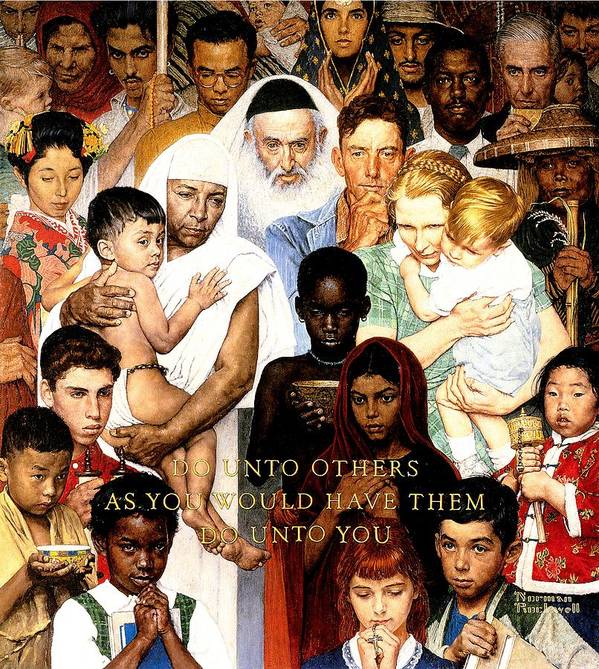
Dear Readers, I ask you to think of this Norman Rockwell painting as my Holiday Greeting Card. It’s one answer to the gravest of questions: How do we as Americans come together after this terrible, horrible, really bad year?
“The Golden Rule” appeared on the cover of the Saturday Evening Post on April 1, 1961. The magazine is no longer around, but back in the day, it was a big deal. And this cover was a big deal. For much of its existence, the Post couldn’t/wouldn’t/didn’t show minorities on its covers. As for the painting itself, it has an interesting history—as does its creator Normal Rockwell—and it reflects the heart of an America that I think most of us want to know and love.
The painting began as a drawing inspired by the creation of the United Nations (1945), to express hope in its peacekeeping mission. The completed drawing featured 65 people representing the world’s nations surrounding key members of the U.N.’s Security Council (US, UK, and Russia—the USSR at the time). Rockwell did extensive research for the piece but abandoned the project because he felt out of his depth. By 1961, he’d been working for the Saturday Evening Post for close to half a century, having done his first cover in 1916 when he was all of twenty-two. By 1961, Rockwell, then 67, was seeing the world in all its complexities. He was celebrated for his often-humorous depictions of small-town America, but his view of America had expanded.
“Without thinking too much about it in specific terms, I was showing the America I knew and observed to others who might not have noticed.” Norman Rockwell
Rockwell’s Golden Rule “DO UNTO OTHERS AS YOU WOULD HAVE THEM DO UNTO YOU” Saturday Evening Post cover coincided with the early years of the Civil Rights movement. Unlike his original drawing, the painting features no diplomats. Instead, Rockwell focuses on the idea of common humanity. (For that cover, Rockwell received hate mail, the first in his 45-year career with the magazine.) Then, in 1985, the painting/message was given new life when it was reimagined as a giant mosaic that was gifted to the U.N. by First Lady Nancy Reagan on behalf of the United States. There it remains in the U.N.’s New York City headquarters.
Norman Rockwell was an American success story. Born in NYC, he dropped out of high school to attend art school. Before he turned sixteen, he’d painted his first commission—Christmas cards. He was still in his teens when the Boy Scouts hired him as the art director for Boys’ Life. He created 322 covers for the Saturday Evening Post, eventually leaving in 1963 to work for Look magazine. He married and raised three sons and moved from New York City to rural Vermont to the small town of Stockton, MA, where he died in 1978. He’s still very much a part of the town. Years ago, friends and I visited the Norman Rockwell Museum, located in “The Old Corner House” on Main Street, which was filled with paintings donated by Rockwell as part of a trust he set up. To gaze at all those originals–the stories they told; the level of detail–is a memory I still carry with me. Today if you wish to visit the museum, it has a new home in a spacious building on a big spread of land.
We all love an American success story, but right now an American patriot story sounds even more appealing. A year before he died, Norman Rockwell was awarded the Presidential Medal of Freedom, the nation’s highest civilian honor, by President Ford. Rockwell was more than just a famous 20th century painter/illustrator whose work made us smile. In 1943, Rockwell was inspired by President Roosevelt’s wartime address to Congress. Rockwell created what came to be known as “The Four Freedoms” paintings: Freedom of Speech, Freedom to Worship, Freedom from Want, Freedom from Fear. Each of the four ran in consecutive issues of the Saturday Evening Post, accompanied by essays by contemporary writers. The magazine got together with the U.S. Treasury Dept. and sponsored an exhibit of the paintings that toured the States and promoted the sale of war bonds. In effect, Rockwell’s Freedom paintings raised more than $130 million for the war effort. His first cover for Look was “The Problem We All Live With,” one of the most iconic paintings of the Civil Rights era, for which he received more hate mail. It’s a portrait of a young black girl in a bright white dress being escorted to school by four U.S. Marshalls. It was based on a real-life incident in 1960, when a six year-old girl named Ruby Bridges was escorted to school in New Orleans while an angry mob shouted and threw things at her.
Throughout his career, Norman Rockwell painted scenes from small town America, but his work also illustrated some of his deepest concerns and interests, including Civil Rights, America’s war on poverty, and space exploration. He was a man of great talent, human empathy, and he was an American patriot.
Wishing you and yours a better, happier, healthier New Year in 2021. With gratitude to Norman Rockwell.
